12 Best Customer Feedback Analysis Tools for 2025
Discover the top customer feedback analysis tools of 2025. Compare features, pricing, and use cases to find the perfect solution for your business.
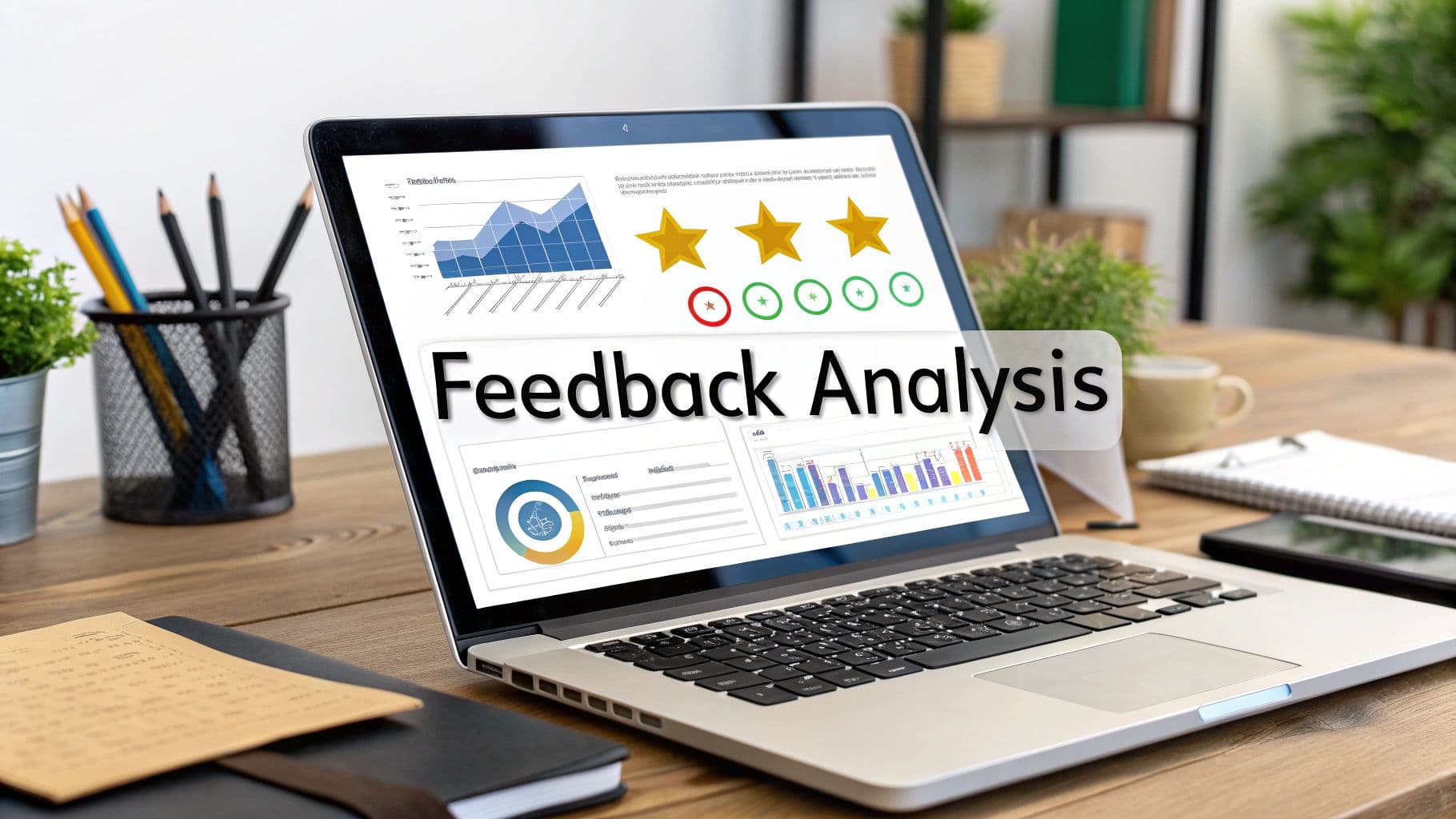
Customer feedback is a goldmine, but most businesses are drowning in data they can't use. Between endless survey responses, support tickets, chat logs, and call transcripts, the sheer volume makes it impossible to manually spot the critical insights that drive growth. Standard tools often just collect data, leaving your team to piece together the story. This guide cuts through the clutter, introducing the 12 best customer feedback analysis tools designed to transform raw data into actionable, revenue-driving strategies.
We'll explore platforms that don't just aggregate feedback but truly analyze it, revealing the hidden patterns in customer behavior that signal churn risks and unlock major expansion opportunities. Forget spending countless hours trying to connect dots between disparate data sources. The right tools automate the process, using AI and sentiment analysis to surface the "why" behind customer actions.
This comprehensive listicle dives deep into each solution, providing an honest assessment of its features, pricing, and ideal use cases. For each tool, you'll find direct links and screenshots to help you visualize its real-world application. Our goal is to equip you with the information needed to select a platform that moves you from simply listening to your customers to truly understanding their needs and taking decisive action.
1. SigOS
SigOS positions itself as a premier AI-driven product intelligence platform, making it one of the most powerful customer feedback analysis tools for modern SaaS companies. It moves beyond simple sentiment analysis by continuously processing feedback from support tickets, chat logs, and sales calls to detect complex behavioral patterns. Its core strength lies in its ability to directly link these patterns to revenue impact, identifying specific issues causing churn and feature requests that could unlock significant expansion opportunities.
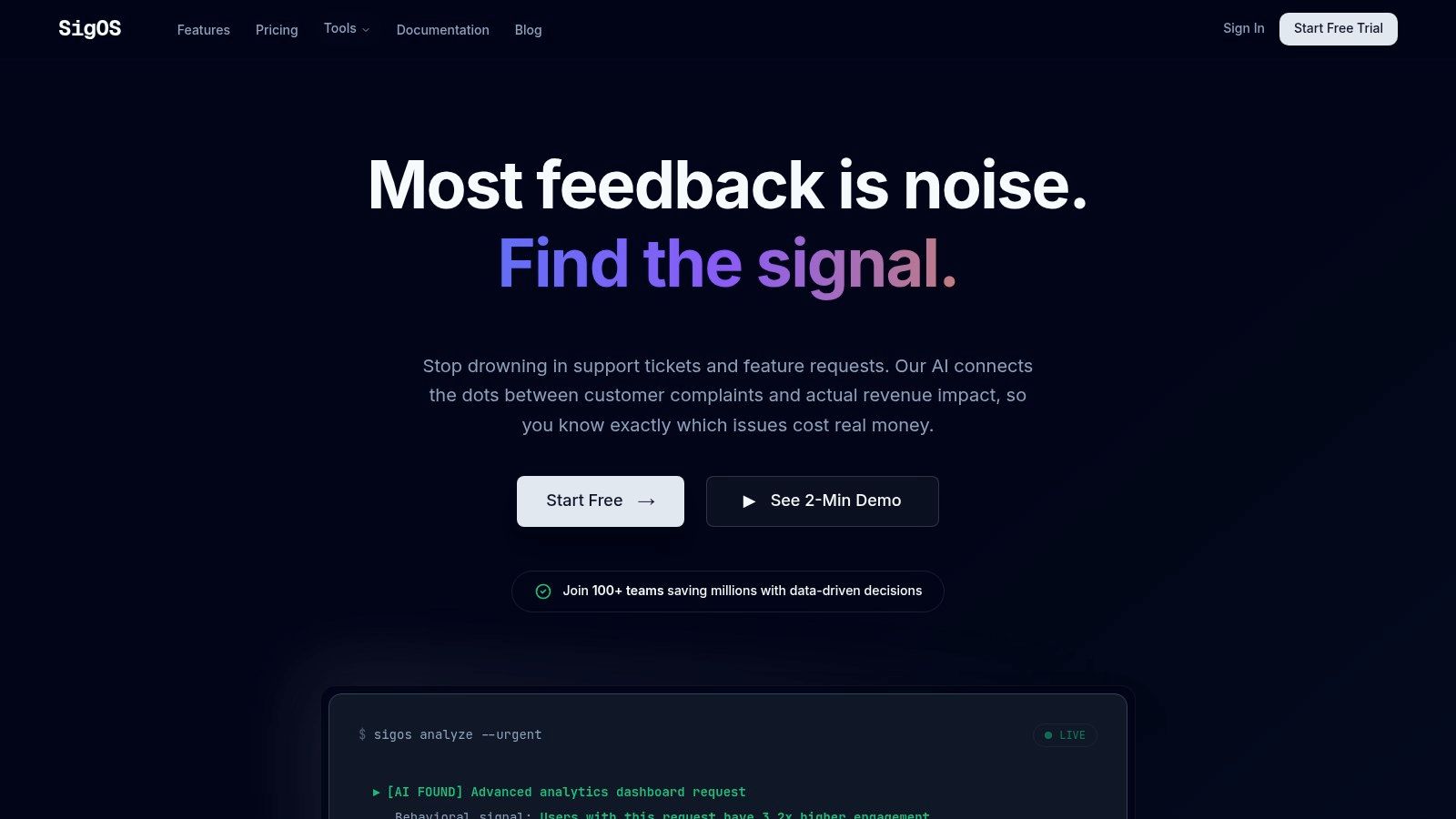
The platform delivers a prioritized daily dashboard, essentially acting as an AI product manager that tells teams exactly where to focus. It highlights critical problems costing the business money and surfaces high-value feature requests, complete with revenue impact scores. This elevates feedback from qualitative noise to a quantifiable strategic asset.
Standout Features and Implementation
SigOS excels with its seamless, automated workflow. By integrating directly with essential tools like Zendesk, Intercom, Jira, and Linear, it automatically creates high-priority issues in your existing project management software. This eliminates manual data entry and ensures that critical insights are acted upon immediately. The platform's real-time alerting system also notifies teams of emerging risks or sudden growth opportunities, enabling proactive decision-making.
For implementation, teams connect their existing data sources, and the AI begins its analysis with a sub-minute processing speed. A key differentiator is its commitment to data privacy; SigOS encrypts all data and never retrains its models on customer-specific information, a critical consideration for enterprises concerned with compliance.
| Feature | Practical Benefit |
|---|---|
| Revenue Impact Scoring | Prioritizes development efforts based on direct financial outcomes, justifying resource allocation. |
| Automated Issue Creation | Instantly pushes critical feedback into engineering workflows (Jira, Linear), accelerating resolution. |
| Real-Time Alerts | Allows teams to address urgent churn risks or capitalize on emerging expansion trends immediately. |
| Behavioral AI Analysis | Uncovers the "why" behind customer actions, providing deeper insights than keyword-based tools. |
Best for: SaaS product managers, customer success leaders, and growth teams who need to connect customer feedback directly to revenue outcomes and prioritize their roadmap with data-backed confidence.
- Pros: Predictive AI with high accuracy, seamless workflow automation with major platforms, and a strong focus on security and data privacy.
- Cons: Pricing is not publicly listed, and its focus is heavily on SaaS and tech companies, which may limit its utility for other industries.
Website: https://sigos.io
2. Qualtrics XM (including Text iQ)
Qualtrics XM is an enterprise-grade experience management platform designed for organizations that need a comprehensive, scalable solution for their Voice of Customer (VoC) programs. It moves beyond simple surveys to provide a holistic view of customer interactions across multiple touchpoints. Its standout feature, Text iQ, uses AI to automatically analyze open-ended feedback, a critical function for any team serious about using customer feedback analysis tools.
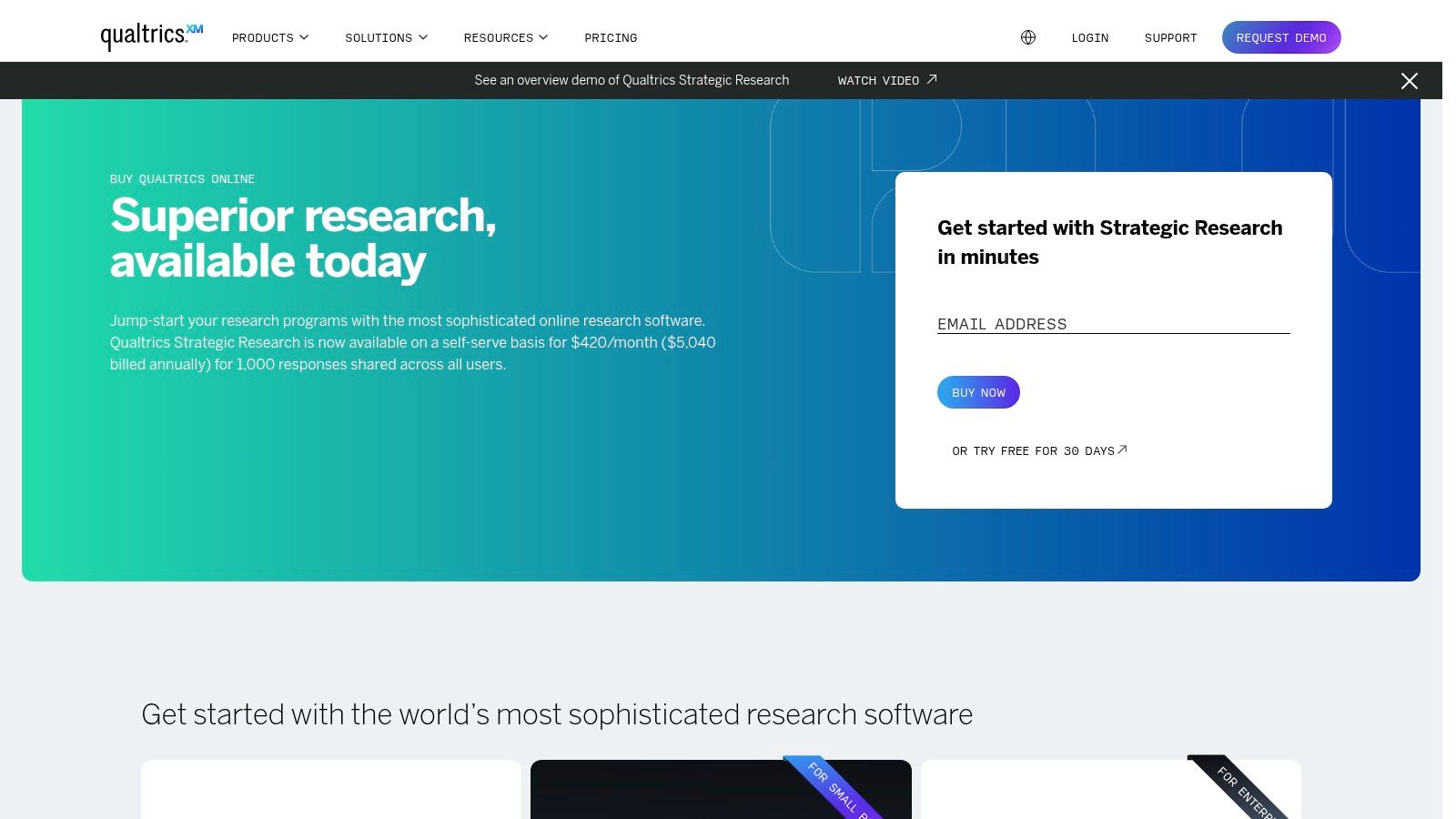
This tool excels at enriching qualitative data with structured tags like sentiment, emotion, effort, and actionability, transforming thousands of comments into quantifiable insights. For product managers, this means quickly identifying which feature requests are causing the most customer friction or delight without manual coding.
Key Features & Use Case
- Text iQ Analytics: Automatically applies sentiment, effort, emotion, and topic analysis to unstructured text, saving hundreds of analyst hours.
- Closed-Loop Workflows: Triggers alerts and assigns cases to specific teams based on feedback rules (e.g., a low NPS score), ensuring prompt follow-up.
- Role-Based Dashboards: Provides customized reporting for everyone from frontline support agents to C-suite executives, ensuring relevant data reaches the right people.
- Advanced Governance: Offers robust security and user permission controls necessary for large, complex organizations handling sensitive customer data.
| Ideal For | Not a Good Fit For |
|---|---|
| Large enterprises with mature VoC programs | Small startups or teams with limited budgets |
| Teams needing deep, automated text analysis | Companies needing a simple, plug-and-play tool |
| Organizations requiring complex integrations | Users who dislike complex setup processes |
Pricing: Qualtrics offers custom enterprise pricing, which can be a significant investment. The plan selection process can be complex, so it's best to engage with their sales team to tailor a package to your specific needs.
Website: https://www.qualtrics.com/buy-online/
3. Medallia Experience Cloud
Medallia Experience Cloud is an enterprise-grade platform built for capturing and analyzing customer feedback signals from every touchpoint, including surveys, social media, speech, and digital interactions. As one of the more comprehensive customer feedback analysis tools, it excels at unifying these disparate data sources into a single view. Its strength lies in using AI-driven analytics to process not just text but also speech and even acoustic patterns, providing deep operational insights.
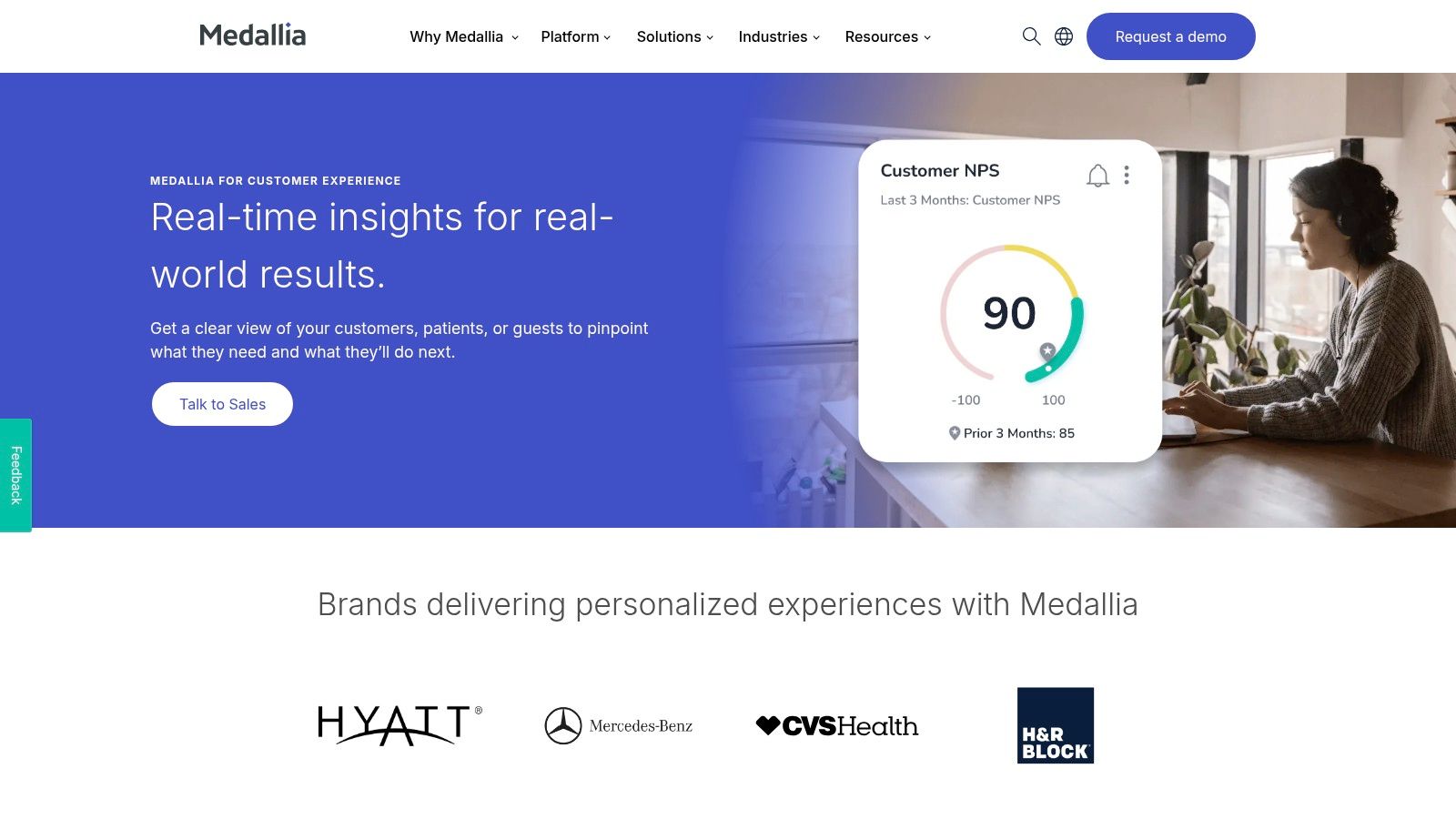
This platform is designed to drive action by embedding insights directly into daily workflows. For example, a contact center manager can use Medallia’s speech analytics to identify agent coaching opportunities that directly impact customer satisfaction, helping to reduce customer churn by addressing root causes of frustration. The system's ability to trigger real-time alerts ensures that issues are handled before they escalate.
Key Features & Use Case
- Unified Signal Capture: Gathers feedback from surveys, web, mobile, social media, and contact center conversations into one platform.
- AI-Powered Analytics: Utilizes text, speech, and acoustic analytics to uncover sentiment, effort, and intent from unstructured feedback.
- Action-Oriented Workflows: Includes built-in alerts and case management to assign tasks and close the loop with customers directly.
- Role-Based Reporting: Delivers tailored dashboards and reports to employees at all levels, from frontline staff to executives.
| Ideal For | Not a Good Fit For |
|---|---|
| Large, multi-location enterprises | Small businesses or teams with simple needs |
| Companies needing holistic, multi-channel VoC | Organizations looking for a self-serve, quick setup |
| Organizations focused on operationalizing insights | Users who need a low-cost, survey-only tool |
Pricing: Medallia’s pricing is custom and typically requires engagement with their sales team. It's often based on the volume of Experience Data Records (EDR) rather than the number of users, making it a scalable option for large organizations.
Website: https://www.medallia.com/suite/customer-experience/
4. SurveyMonkey (Momentive) – Surveys with Sentiment Analysis
SurveyMonkey is one of the most recognizable names in online surveys, but its evolution under Momentive has incorporated powerful features for customer feedback analysis. While known for its ease of use, its higher-tier plans offer automated sentiment analysis, transforming it from a simple data collection tool into a platform for initial qualitative insight. The standout capability is its ability to automatically process open-ended responses and tag them as positive, negative, or neutral.

This functionality allows teams to quickly segment thousands of comments without manual review, providing a high-level understanding of customer emotion. For a product manager launching a new feature, this means you can instantly gauge whether the initial verbatim feedback is leaning positive or negative, guiding your next steps for deeper analysis or immediate action.
Key Features & Use Case
- Built-in Sentiment Analysis: Automatically categorizes open-ended text responses to quickly identify customer mood and trends on select paid plans.
- Team Collaboration: Team plans offer administrative controls, shared asset libraries, and collaborative workflows for analyzing feedback together.
- Extensive Template Library: Provides hundreds of expert-written templates, including NPS, CSAT, and product feedback, to accelerate survey deployment.
- Key Integrations: Connects with popular tools like Salesforce, HubSpot, and Slack to feed survey data directly into existing business workflows.
| Ideal For | Not a Good Fit For |
|---|---|
| Teams needing a fast, user-friendly survey and analysis tool | Organizations requiring deep, multi-layered topic modeling |
| Users with a familiar interface for quick deployment | Teams on a tight budget needing free sentiment analysis |
| Companies looking for flexible individual and team plans | Users who need highly complex, custom workflow automation |
Pricing: SurveyMonkey offers a free basic plan, but sentiment analysis and other advanced features are available on paid Team plans (starting at $25/user/month) and Enterprise plans. It's important to review plan features carefully to ensure they meet your analysis needs.
Website: https://www.surveymonkey.com/pricing/
5. Hotjar – Ask (Surveys & Feedback)
Hotjar is a lightweight experience insights platform that excels at connecting what users say with what they do. Its Ask tools, which include on-site surveys and an always-on feedback widget, are perfect for gathering in-the-moment feedback directly within your product or on your website. The platform stands out by integrating this qualitative data directly with behavioral analytics like heatmaps and session recordings.
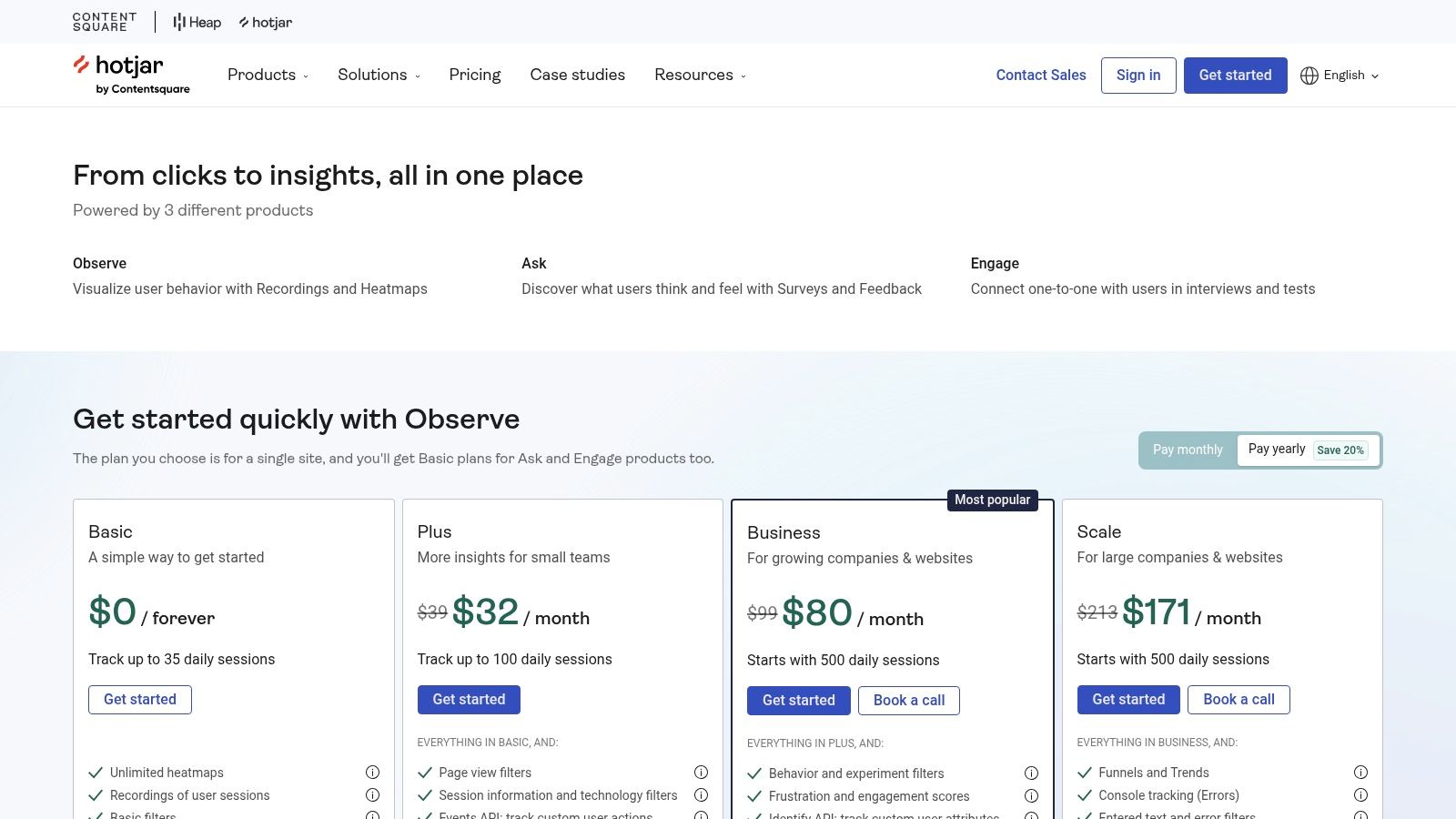
This integration is a game-changer for product and UX teams. Instead of just reading a customer's comment, you can click to watch the exact session recording tied to that piece of feedback, providing invaluable context. Its new AI-powered features for survey creation and response summaries streamline the process, making it one of the most efficient customer feedback analysis tools for quick insights.
Key Features & Use Case
- AI-Powered Surveys: Generate relevant survey questions automatically and get instant summaries of open-ended responses, reducing manual analysis time.
- Integrated Behavioral Context: Link survey answers and feedback submissions directly to corresponding session recordings and heatmaps to understand user behavior.
- On-Site Feedback Widgets: Capture continuous, passive feedback from users with a non-intrusive widget available on any page.
- Targeted Survey Triggers: Launch surveys based on specific user actions, such as exit intent, time on page, or clicking a particular element.
| Ideal For | Not a Good Fit For |
|---|---|
| Product and UX teams needing context behind user feedback | Organizations needing a comprehensive, enterprise VoC suite |
| Teams wanting a quick, simple setup for on-site feedback | Users requiring deep, standalone text analytics capabilities |
| Companies on a budget, thanks to its generous free tier | Teams that need to analyze feedback from many external sources |
Pricing: Hotjar offers a free "Basic" plan with limited responses. Paid plans (Plus, Business, Scale) start at around $32/month and increase based on the number of sessions and responses you need to capture.
Website: https://www.hotjar.com/pricing/
6. Sprig – In-Product Surveys, Feedback, and AI Analysis
Sprig is a product-led research platform that excels at capturing real-time user feedback directly within a product experience. It moves beyond traditional email surveys by allowing teams to launch targeted, in-product surveys and capture continuous feedback. Its AI-powered analysis is the core of its offering, making it one of the most agile customer feedback analysis tools for modern product teams.

The platform’s AI automatically summarizes open-text responses, groups feedback into actionable themes, and generates study summaries. For product managers, this means quickly validating hypotheses or identifying usability issues without the manual overhead of sifting through hundreds of comments. The AI Explorer feature allows users to query across all feedback sources, synthesizing insights from surveys, replays, and heatmaps into a unified view.
Key Features & Use Case
- AI-Powered Analysis: Automatically summarizes open-text feedback, groups it into themes, and generates study summaries to accelerate insight discovery.
- In-Product Surveys: Target users with specific surveys based on their actions and behaviors within your app for highly contextual feedback.
- AI Explorer: Ask natural language questions across all your research data (surveys, feedback, replays) to get synthesized answers instantly.
- Always-On Feedback Capture: Implements a continuous feedback widget within your product so users can report issues or ideas at any time.
| Ideal For | Not a Good Fit For |
|---|---|
| Product-led teams needing rapid, in-context insights | Companies without a digital product or app |
| Teams looking to automate qualitative data synthesis | Organizations needing broad multi-channel VoC |
| Users who want a free plan for initial testing | Teams that require a fixed, predictable monthly cost |
Pricing: Sprig offers a free plan to get started. Paid plans use a usage-based model and require contacting their sales team for a custom quote, which can make budgeting less predictable for larger teams.
Website: https://sprig.com/pricing
7. Chattermill – Customer Feedback Analytics
Chattermill is an AI-powered platform designed to unify customer feedback from disparate sources into a single, cohesive view. It excels at consolidating data from surveys, support tickets, app reviews, and social media, then applying sophisticated theme and sentiment analysis. Its unique strength lies in Lyra AI, which provides deep text analytics across multiple languages, making it a standout among customer feedback analysis tools for global organizations.
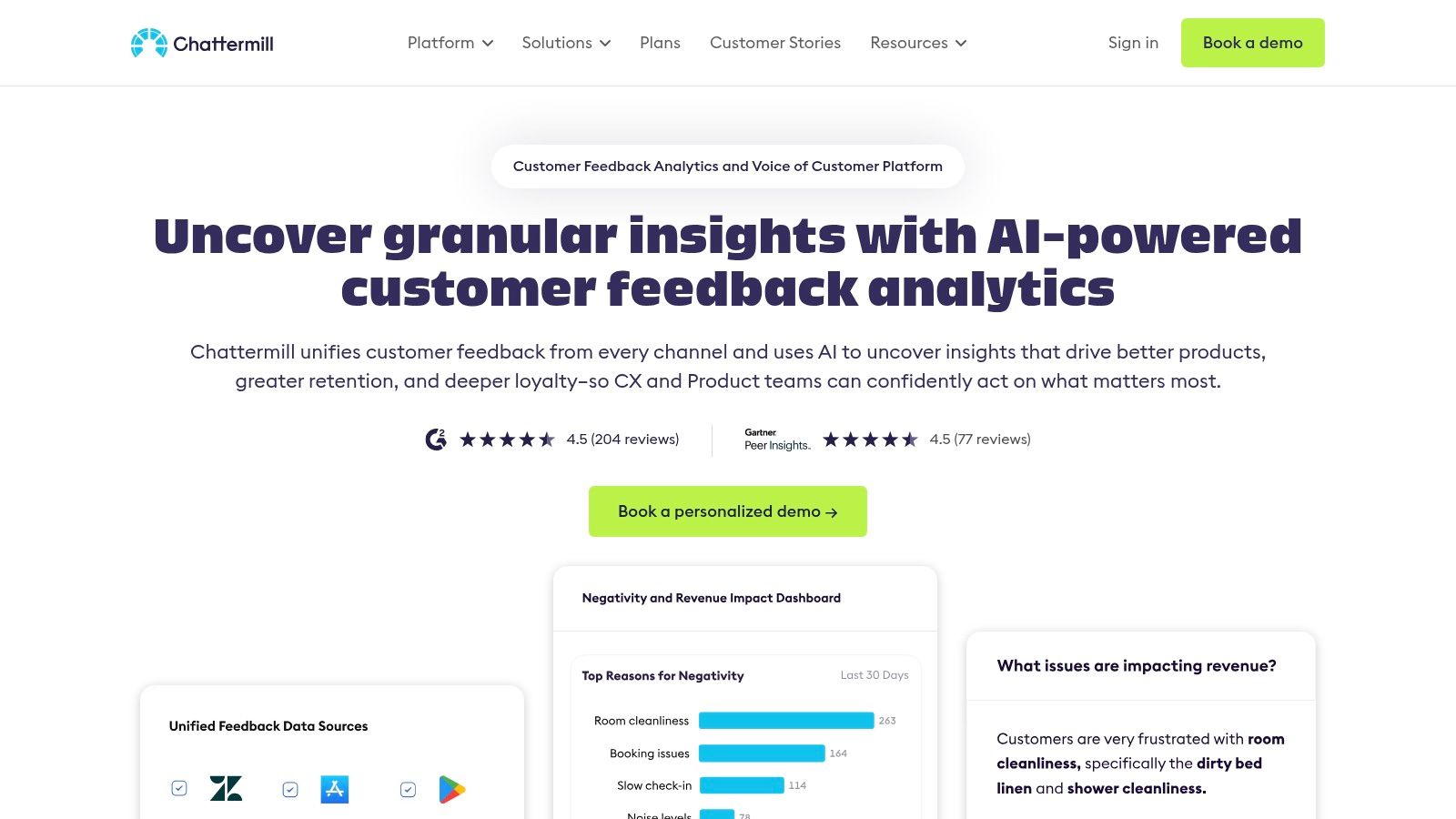
The platform is built for scale, allowing teams to understand customer needs by moving beyond high-level scores to the "why" behind customer behavior. Product teams can use its unlimited, shareable dashboards to track feature requests and bug reports across all channels, while customer support leaders can identify the root causes of contact volume and dissatisfaction.
Key Features & Use Case
- Unified AI Analytics: Consolidates and analyzes feedback from sources like SurveyMonkey, Zendesk, and app stores using a single AI engine for consistent insights.
- Multi-Language Support: Lyra AI processes and categorizes feedback in numerous languages, essential for businesses with an international customer base.
- Unlimited Users & Dashboards: Encourages collaboration by allowing entire organizations to access and build reports without incurring per-seat licensing fees.
- Prebuilt Integrations: Offers seamless connections to popular tools including Qualtrics, Intercom, and Snowflake for a comprehensive data ecosystem.
| Ideal For | Not a Good Fit For |
|---|---|
| Global teams needing multi-language analysis | Small businesses with low feedback volume (<5k items/month) |
| Organizations with feedback scattered across many platforms | Teams seeking a simple, low-cost survey tool |
| Companies that want to avoid per-user pricing models | Users who require transparent, fixed-price plans |
Pricing: Chattermill uses a quote-based model based on data credits and the number of integrations. It is optimized for companies processing over 5,000 pieces of feedback monthly, making it a powerful but significant investment.
Website: https://chattermill.com/
8. Thematic – AI Feedback Analytics
Thematic is an AI-powered feedback analysis platform built for CX and Insights teams who need to quickly and accurately find themes in their customer comments. It specializes in transforming large volumes of unstructured data from sources like surveys, reviews, and support tickets into quantifiable insights. Thematic’s strength lies in its automated theme extraction and sentiment tagging, which helps teams uncover specific customer issues without the heavy lifting of manual coding.
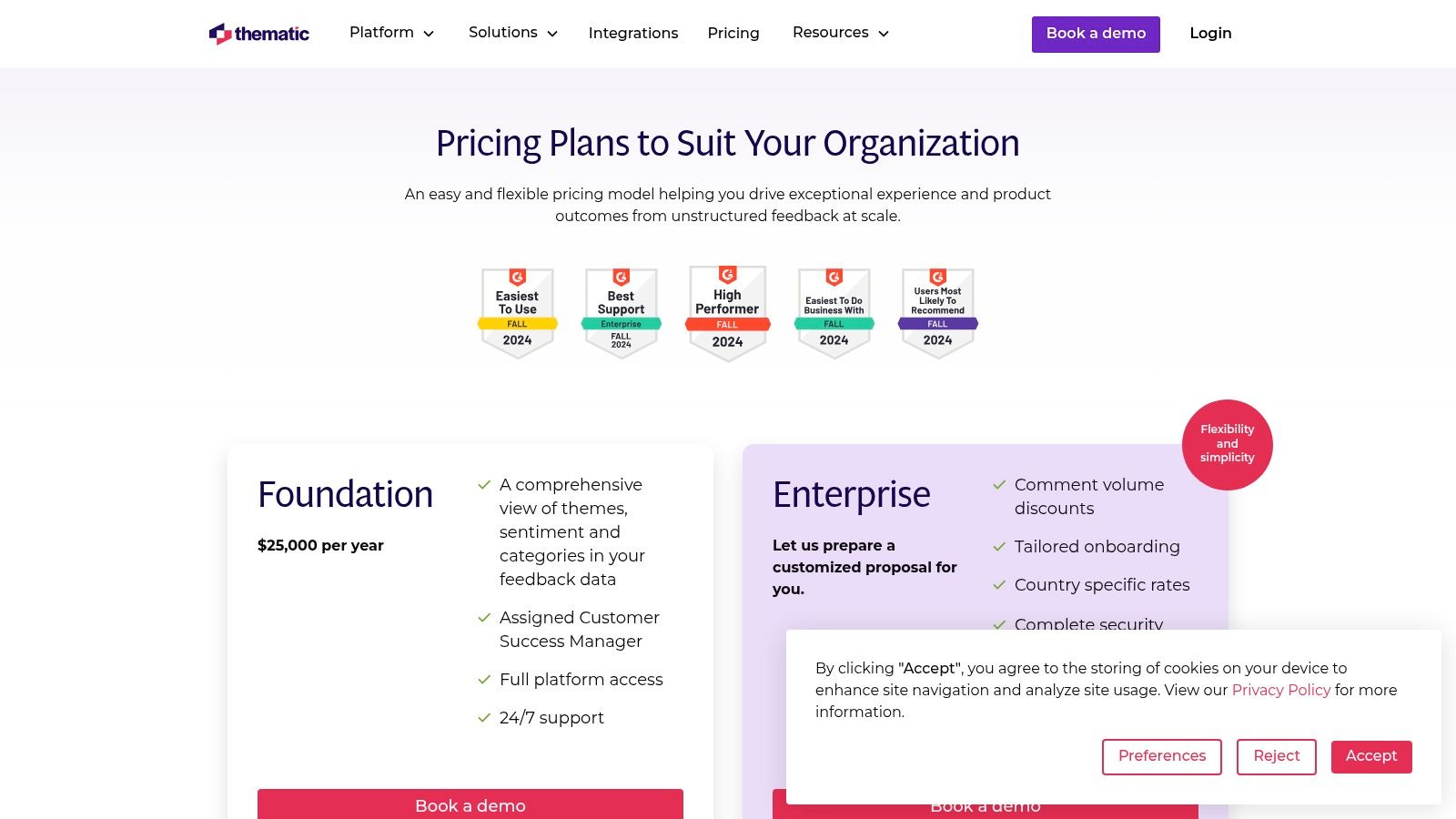
This tool is particularly useful for product and CX managers who need to justify roadmap decisions with hard data. For example, it can quantify how many customers are complaining about a specific bug or requesting a new integration, linking qualitative feedback directly to business metrics like NPS or churn risk. The emphasis on security, with SOC 2 Type II and GDPR compliance, also makes it a trusted choice for organizations handling sensitive data.
Key Features & Use Case
- Automated Theme Discovery: AI identifies and categorizes emerging themes from customer feedback, allowing teams to spot trends as they happen.
- Sentiment and Sub-theme Analysis: Digs deeper than just positive or negative sentiment, identifying nuanced sub-themes within broader categories.
- One-Click Integrations & API: Connects easily with popular survey tools, CRMs, and support platforms to centralize feedback analysis.
- Strong Security & Compliance: SOC 2 Type II and GDPR compliant, making it suitable for enterprises with strict data governance requirements.
| Ideal For | Not a Good Fit For |
|---|---|
| CX and Insights teams needing fast time-to-insight | Teams looking for an all-in-one feedback collection tool |
| Companies with high volumes of text feedback | Organizations that prefer a one-time purchase over a subscription |
| Users who value analyst-ready outputs | Small teams with very limited and infrequent feedback volume |
Pricing: Thematic offers a transparent, volume-based pricing model starting with an entry-level plan, though it is based on annual contracts. Advanced enterprise features and higher comment volumes require upgrading to a higher-tier plan, so it's best to consult their team for a custom quote.
Website: https://getthematic.com/product/plan-and-pricing
9. MonkeyLearn – No-Code Text Analysis
MonkeyLearn is a powerful, no-code text analysis platform designed to make Natural Language Processing (NLP) accessible to business users. It excels at training custom machine learning models to classify and extract insights from unstructured customer feedback like survey responses, support tickets, and online reviews. Its standout feature is the ability for non-technical users to build and deploy highly specific custom text classifiers with minimal effort.
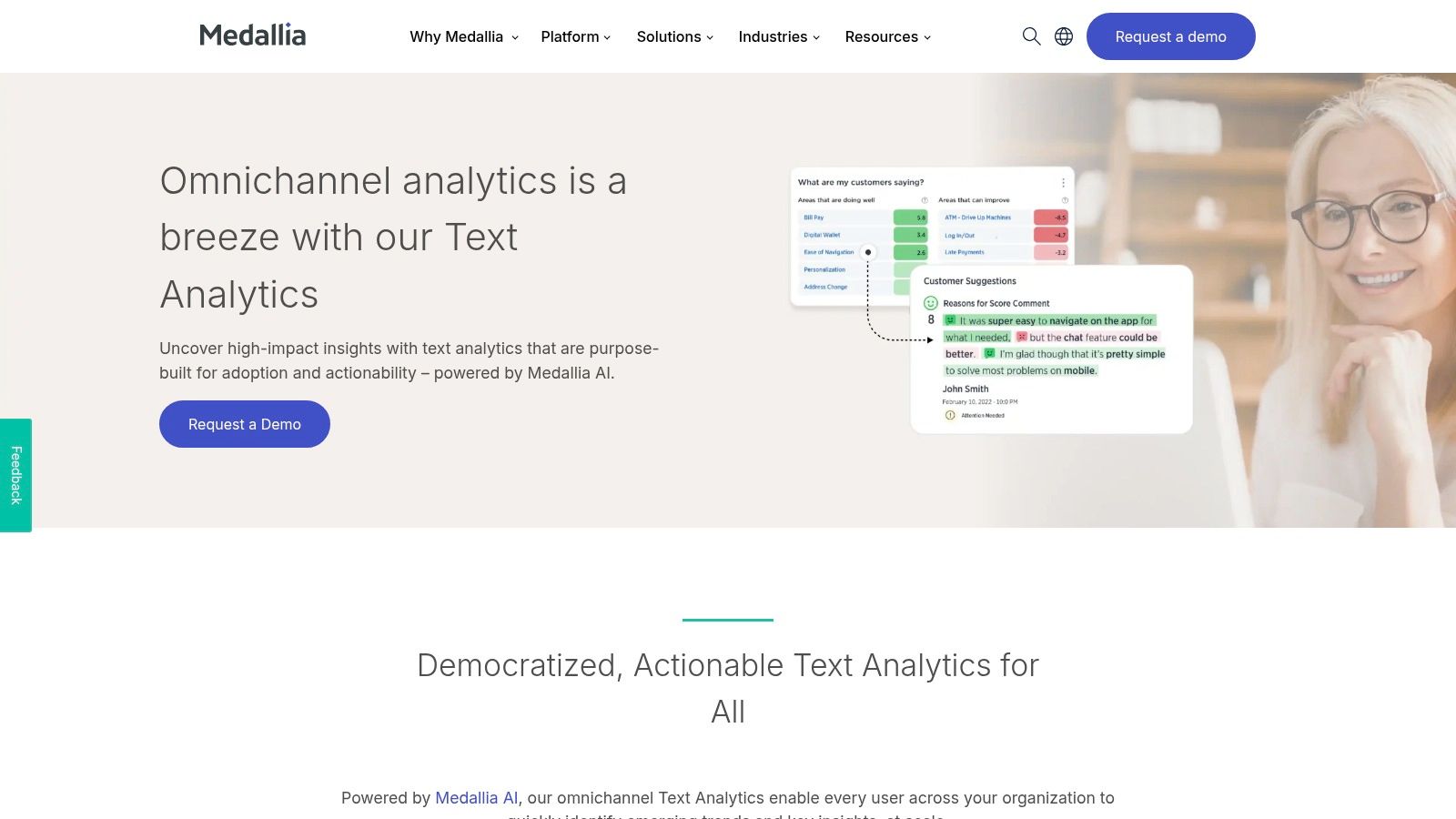
This tool empowers teams to go beyond generic sentiment and automatically tag feedback with custom topics relevant to their product, such as "UI/UX issues" or "Feature Request: Reporting". For product managers, this means transforming a chaotic inbox of qualitative data into a structured, queryable database for prioritizing the product roadmap with one of the most flexible customer feedback analysis tools available.
Key Features & Use Case
- Custom NLP Models: Build and train your own text classifiers and extractors to tag feedback for topics, sentiment, keywords, and intent without writing code.
- Pre-Built Integrations: Connects directly with popular tools like Zapier, Google Sheets, and Zendesk to create automated feedback analysis workflows.
- Data Visualization Studio: A built-in dashboarding tool that helps you visualize the classified data, track trends over time, and share insights across the organization.
- Developer API: Offers a robust API for developers who need to integrate custom-trained models into their own applications and data pipelines.
| Ideal For | Not a Good Fit For |
|---|---|
| Teams wanting to build custom feedback classification | Users needing a simple, out-of-the-box survey tool |
| Product managers and analysts needing flexible text mining | Organizations looking for an all-in-one CX management suite |
| Users comfortable with an API-first or integration-led setup | Teams with very small budgets or infrequent analysis needs |
Pricing: MonkeyLearn's pricing is not publicly listed and is provided upon request via a demo. It is generally positioned for businesses looking for a scalable, customizable text analysis solution, so entry costs may be higher than some basic SMB tools.
Website: https://monkeylearn.com/
10. Keatext – AI Text Analytics for CX
Keatext is an AI-powered text analytics platform specifically designed for customer experience (CX) teams. Its primary strength lies in its ability to automatically categorize unstructured feedback into immediately actionable groups like Problems, Praises, Suggestions, and Questions. This allows teams to move beyond sentiment analysis and understand the specific intent behind customer comments, making it a powerful tool for prioritizing product roadmaps and support initiatives.
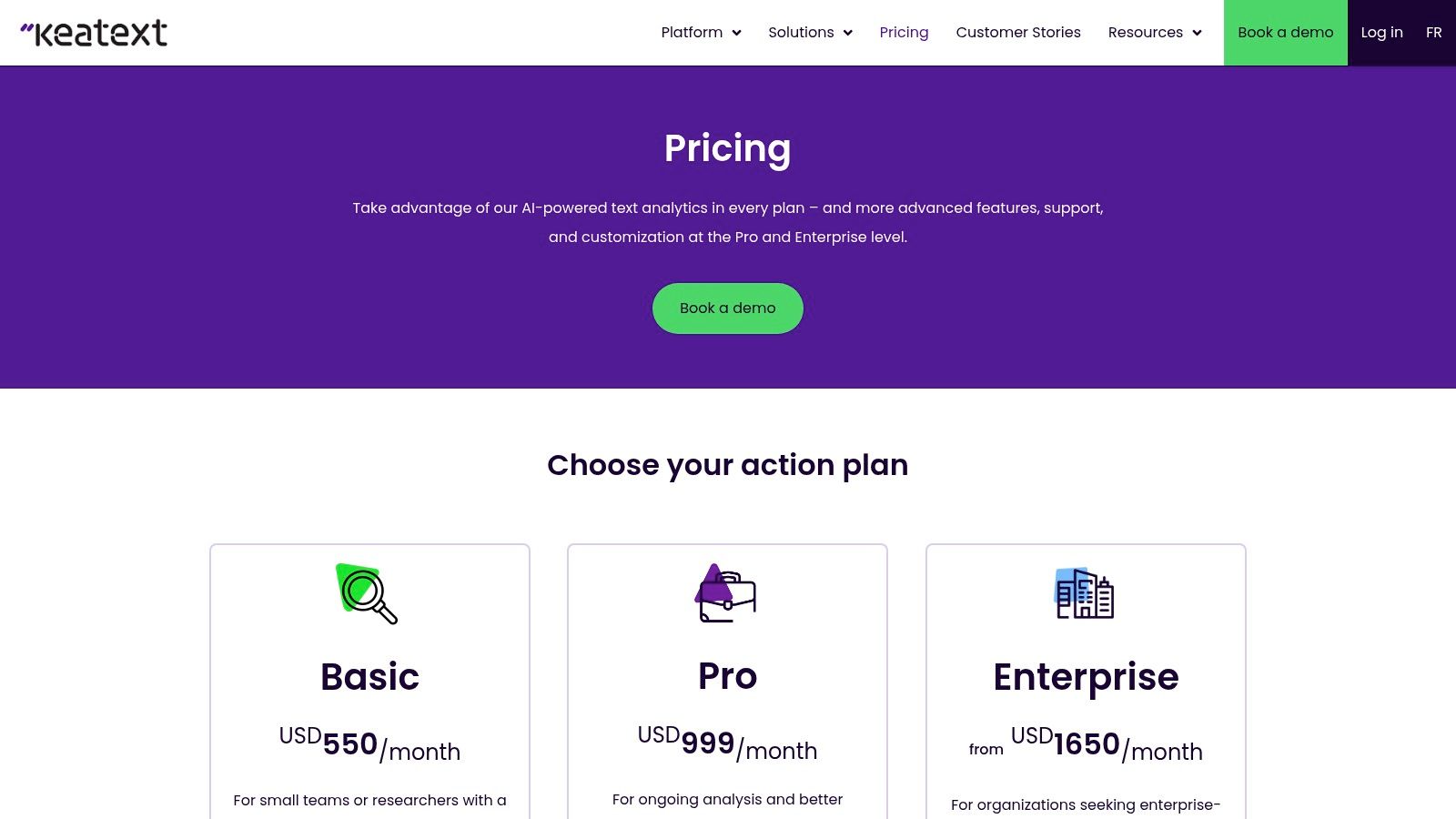
The platform excels at identifying emerging trends and connecting them to key performance indicators (KPIs), such as CSAT or NPS. This helps CX leaders demonstrate the direct business impact of addressing specific feedback themes. By visualizing how certain problems or suggestions affect core metrics, Keatext provides the data-driven evidence needed to secure resources for improvements, a key aspect of modern enterprise data analytics.
Key Features & Use Case
- AI-Driven Categorization: Automatically classifies feedback into Problems, Praises, Suggestions, and Questions for quick, intent-based analysis.
- Key Driver Analysis: Connects feedback topics directly to business KPIs, revealing which issues have the biggest impact on customer satisfaction or churn.
- Trend Detection: Proactively identifies emerging issues or popular suggestions, allowing teams to respond before they escalate.
- Multilingual Support: Analyzes feedback from over 50 languages, making it suitable for global companies with diverse customer bases.
| Ideal For | Not a Good Fit For |
|---|---|
| CX and support teams focused on actionable insights | Teams needing an all-in-one survey and feedback tool |
| Companies needing to quantify the impact of qualitative data | Individuals looking for a free or very low-cost solution |
| Global organizations managing multilingual feedback | Users who require extensive, out-of-the-box integrations |
Pricing: Keatext offers transparent, tiered pricing based on the number of feedback records analyzed annually. The entry-level plan starts at a defined record limit, with higher tiers offering more volume, features, and dedicated support. Some integrations are available as paid add-ons.
Website: https://www.keatext.ai/en/pricing/
11. G2 – Feedback Analytics Software Category (comparison marketplace)
Instead of being a singular tool, G2's Feedback Analytics category serves as an independent marketplace and research hub for discovering the right customer feedback analysis tools. It aggregates up-to-date listings, verified peer reviews, and detailed feature comparisons, making it an essential starting point for any team looking to shortlist vendors. Its value lies in providing social proof and real-world validation from actual users across different industries.
For product managers and team leads, G2 streamlines the initial research phase. You can use its filters to segment potential tools by company size, industry, or specific features, quickly narrowing a long list of possibilities down to a manageable few. The side-by-side comparison grids are particularly useful for evaluating how different platforms stack up on key functionalities.
Key Features & Use Case
- Verified User Peer Reviews: Offers authentic satisfaction scores and detailed reviews from real users, providing insights beyond marketing copy.
- Feature Comparison Grids: Allows for direct, feature-level comparisons between multiple tools in a structured grid format.
- Segmented Shortlisting: Enables users to filter solutions by company size (SMB, Mid-Market, Enterprise) and industry to find the most relevant options.
- Vendor Research Hub: Provides direct links to vendor websites, pricing information, and demo request pages, centralizing the initial procurement process.
| Ideal For | Not a Good Fit For |
|---|---|
| Teams starting their research for a new tool | Users who have already selected and need to use a tool |
| Validating vendor claims with user feedback | In-depth, hands-on product evaluation |
| Comparing multiple tools on specific features | Anyone seeking a single, direct software solution |
Pricing: G2 is free to use for buyers and researchers. Vendors may pay for sponsored listings or enhanced profiles, so it's wise to cross-reference top-ranked options with your own independent research.
Website: https://www.g2.com/categories/feedback-analytics
12. Salesforce AppExchange – Surveys & Feedback Apps (marketplace)
For organizations already embedded in the Salesforce ecosystem, the AppExchange is the most direct path to finding integrated customer feedback analysis tools. It’s not a single tool but a curated marketplace of third-party applications designed to work natively within Salesforce. This provides a distinct advantage: feedback collected from surveys or other channels can be instantly linked to customer records, cases, and opportunities, enabling powerful closed-loop workflows directly within your CRM.
This platform’s value lies in its seamless integration. Instead of exporting data between systems, teams can trigger follow-up actions, update contact records with sentiment data, or create service cases based on negative feedback, all from one place. This makes it a go-to resource for service and sales teams who need to act on customer insights without leaving their primary work environment.
Key Features & Use Case
- Native Salesforce Integration: Apps are built to connect directly with Salesforce objects, streamlining workflows like feedback-to-case or feedback-to-lead creation.
- Vetted App Listings: All applications are reviewed by Salesforce, and user reviews provide social proof and real-world insights into an app’s performance and reliability.
- Specialized Categories: The marketplace features dedicated sections for Surveys and Customer Satisfaction tools, making it easy to find relevant applications.
- Edition & Install Details: Listings clearly state which Salesforce editions are compatible and outline the installation process, reducing implementation friction.
| Ideal For | Not a Good Fit For |
|---|---|
| Companies heavily invested in the Salesforce CRM | Organizations not using Salesforce |
| Teams needing seamless, closed-loop workflows | Users seeking a standalone, all-in-one feedback platform |
| Businesses wanting to enrich CRM data with VoC | Teams looking for a tool with a very simple, quick setup |
Pricing: Varies widely by app. Many offer free trials or freemium versions, while others have subscription fees based on user count or feature tiers. Each app listing details its own pricing model.
Website: https://appexchange.salesforce.com/mktcollections/curated/guide-for-service-apps
Customer Feedback Analysis Tools Comparison
| Product / Platform | Core Features / Capabilities | User Experience & Quality ★ | Value Proposition 💰 | Target Audience 👥 | Unique Selling Points / Highlights ✨ |
|---|---|---|---|---|---|
| 🏆 SigOS | AI-driven behavioral analysis, real-time alerts, seamless integrations | ★★★★☆ 87% accuracy, sub-minute analysis | Contact for pricing, proven ROI 💰 | SaaS, product & growth teams 👥 | Revenue impact prioritization, security-first, automated issue creation ✨ |
| Qualtrics XM (including Text iQ) | AI text analytics, sentiment/emotion tagging, multilingual | ★★★★☆ Strong VOC analytics | Premium pricing 💰 | Large enterprises, VOC programs 👥 | Rich survey language support, broad governance ✨ |
| Medallia Experience Cloud | Multi-channel feedback, AI text & speech analytics | ★★★★☆ Scalable for multi-location | Pricing per Experience Data Records 💰 | Large enterprises 👥 | Unified feedback capture, closed-loop actioning ✨ |
| SurveyMonkey (Momentive) | Surveys with automated sentiment, templates, team controls | ★★★☆☆ Easy to use, fast deployment | Paid tiers for advanced features 💰 | SMBs, teams 👥 | Familiar UI, flexible plans ✨ |
| Hotjar – Ask | On-site surveys, AI survey generation, feedback widgets | ★★★☆☆ Simple setup, generous free tier | Tiered pricing, response limits 💰 | Product & UX teams 👥 | Heatmaps/session integrations, always-on feedback ✨ |
| Sprig | In-product surveys, AI feedback summarization | ★★★☆☆ Real-time insights, free plan | Usage-based, sales contact needed 💰 | Product teams 👥 | AI Explorer for cross-study insights ✨ |
| Chattermill | Multi-source feedback, multi-language, unlimited dashboards | ★★★☆☆ Effective at scale | Quote-based, volume optimized 💰 | Large enterprises, multilingual 👥 | "Lyra AI" multi-language analytics ✨ |
| Thematic | Automated theme extraction, sentiment tagging | ★★★★☆ Analyst-focused outputs | Transparent volume-based pricing 💰 | CX & insights teams 👥 | SOC 2 & GDPR compliant, API access ✨ |
| MonkeyLearn | No-code text classifiers, sentiment & keyword extraction | ★★★☆☆ Accessible & flexible | Not clearly listed, higher SMB cost 💰 | Non-developers, prototyping 👥 | Custom model building, APIs for automation ✨ |
| Keatext | CX text analytics, sentiment & topic modeling, KPI dashboards | ★★★★☆ CX-centric with shareable filters | Transparent pricing tiers 💰 | CX teams, multilingual 👥 | Advanced topic modeling, 50+ language support ✨ |
| G2 (Marketplace) | Peer reviews, feature grids, pricing info | ★★★★☆ Real-world user insights | Free to use, vendor validation | Buyers & researchers 👥 | Verified reviews, segmented filtering ✨ |
| Salesforce AppExchange (Market) | Salesforce-native surveys & feedback apps | ★★★☆☆ Streamlined CRM integrations | Varies by app, Salesforce-dependent | Salesforce users 👥 | Tight CRM integration, vetted apps ✨ |
From Data to Decisions: Making Your Choice
Navigating the landscape of customer feedback analysis tools can feel overwhelming, but the journey from raw data to actionable decisions is more achievable than ever. We've explored a diverse range of platforms, from comprehensive enterprise suites like Qualtrics and Medallia, ideal for large-scale Voice of the Customer programs, to more focused, agile solutions like Sprig for in-product insights and Chattermill for unified analytics. The common thread among these powerful tools is a fundamental shift away from simple data collection towards intelligent, AI-driven interpretation.
The most critical takeaway is that there is no single "best" tool for everyone. Your ideal solution depends entirely on your company's unique context: your business stage, the volume and variety of your feedback channels, your technical resources, and your primary strategic goals. Simply gathering more feedback is not the answer; the real value lies in understanding the "why" behind the data and connecting those insights directly to business outcomes.
How to Choose the Right Tool for Your Team
To find the perfect fit, start by conducting an internal audit. Don't let a feature list drive your decision. Instead, let your specific pain points guide your evaluation.
- For Product-Led SaaS Companies: If your primary challenge is connecting disparate feedback from sources like Intercom, Zendesk, and G2 directly to your product roadmap and revenue metrics, a specialized product intelligence platform like SigOS is designed for this exact purpose.
- For Enterprise-Wide CX Programs: If you need a robust, all-in-one system to manage complex, multi-channel feedback across a large organization, the extensive capabilities of Medallia or Qualtrics XM will provide the necessary scale and governance.
- For Lean Teams Needing Quick Insights: If you're a smaller team or just starting your feedback analysis journey, tools like Hotjar's Ask or SurveyMonkey offer accessible entry points to capture and analyze user sentiment without a steep learning curve.
- For Data Teams Seeking Customization: If you have existing data streams and require a flexible, no-code solution to build custom text analysis models, platforms like MonkeyLearn or Thematic offer powerful, API-driven flexibility.
Final Thoughts on Implementation
Once you've shortlisted potential customer feedback analysis tools, prioritize a pilot program or free trial. Integrate a primary data source and test the platform against a real business question you're currently facing. Evaluate not just the features, but the user experience for your team. The right tool should feel like a strategic partner, one that empowers your team to move faster, prioritize with greater confidence, and build a truly customer-centric culture. Ultimately, the goal is to transform customer feedback from a reactive support queue into your most valuable proactive asset for growth.
Ready to stop manually tagging feedback and start connecting customer insights directly to revenue? SigOS is the product intelligence platform designed for SaaS teams to automatically unify, analyze, and prioritize feedback, ensuring your product roadmap is always aligned with your most valuable customers. Discover how SigOS can turn your customer feedback into a strategic advantage.


